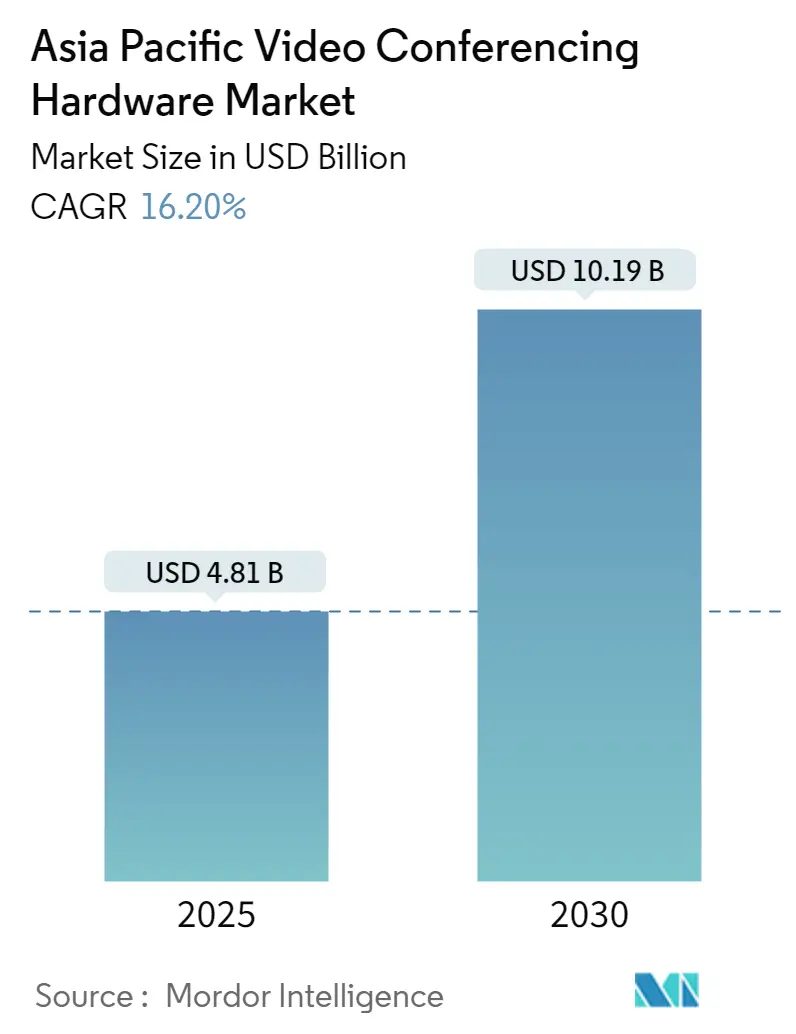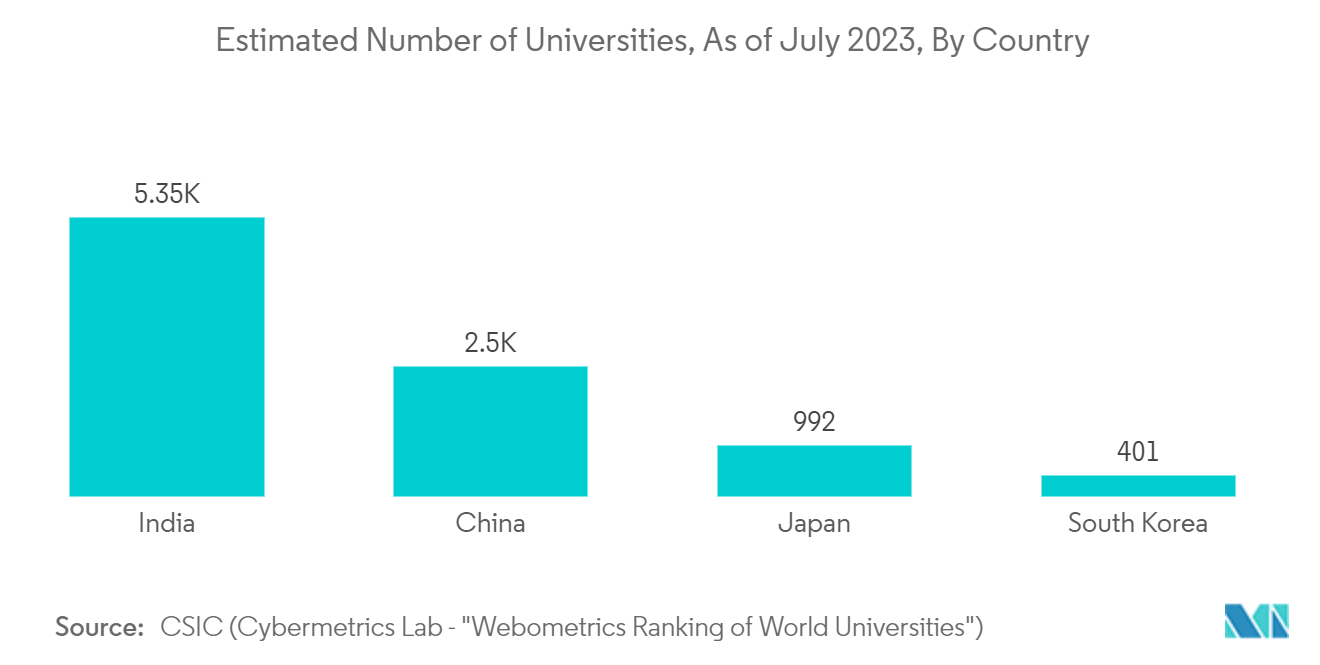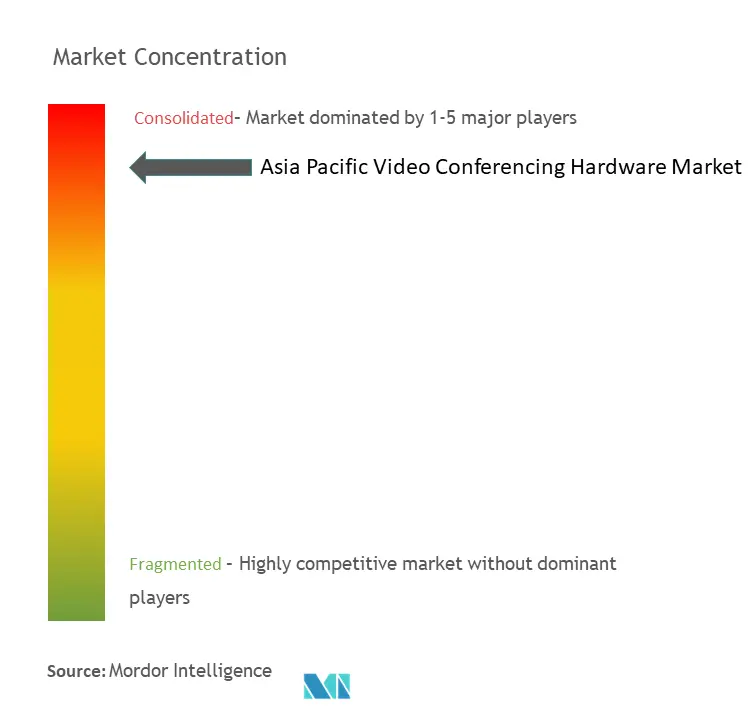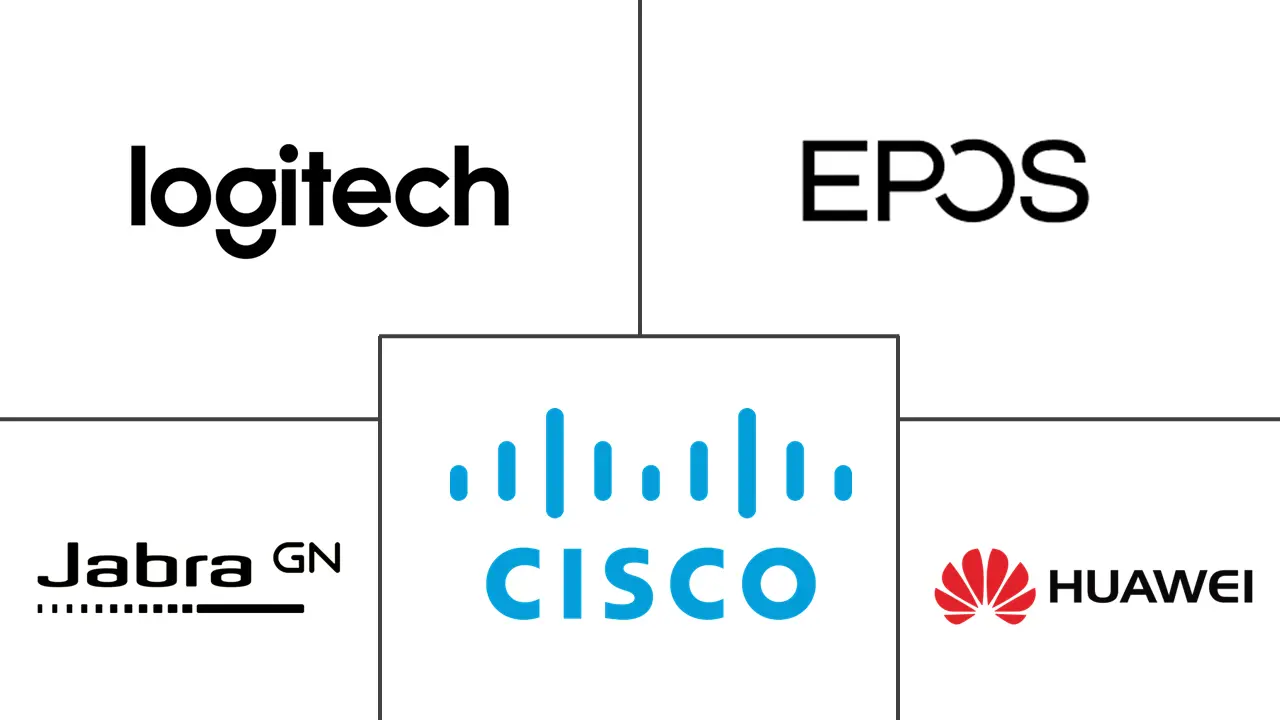Asia Pacific Video Conferencing Hardware Market Size and Share

Asia Pacific Video Conferencing Hardware Market Analysis by Mordor Intelligence
The Asia Pacific Video Conferencing Hardware Market size is estimated at USD 4.81 billion in 2025, and is expected to reach USD 10.19 billion by 2030, at a CAGR of 16.2% during the forecast period (2025-2030).
- Video conferencing has become crucial for businesses of all sizes and sectors, from overseeing remote teams to finalizing international business deals. To remain competitive, firms and organizations must offer clients and staff a reliable solution for high-quality video conferencing, which is crucial for remote work and communication. Having reliable video conferencing equipment can significantly improve the overall standard of the meetings. A high-quality camera that can produce clear and sharp video, even in dimly lit environments, is essential for any conference space. Combined with a top-notch microphone and speaker, it guarantees that everyone participating in the meeting is visible and audible regardless of location.
- Moreover, growing globalization and expanding businesses compel effective communication and collaboration tools, driving the demand for video conferencing hardware. The increasing adoption of video conferencing solutions in educational institutions for online learning, virtual classrooms, and remote training programs drives the demand for video conferencing hardware among institutions.
- For instance, in April 2024, according to Logitech company, adopting hybrid work models presents a significant opportunity for India's video conferencing hardware market. Programs like 'Digital India' by the government promote the adoption of technology and establish a solid environment for electronic manufacturers within the country, which will drive growth in the market. Logitech company discussed the future strategies for the Indian market, mentioning that the company's product team regularly engages with customers to gather feedback that shapes the development of video conferencing hardware products.
- The initial investment required for video conferencing hardware, including USB cameras, displays, audio equipment, and networking infrastructure, can be significant for organizations with limited budgets. Moreover, in some remote or underdeveloped areas, adequate internet connectivity, reliable network infrastructure, and sufficient bandwidth may limit the adoption of video conferencing hardware.
- Exchange rate fluctuations and currency volatility can impact the cost of video conferencing hardware imports and exports, affecting the pricing strategies, profit margins, and market competitiveness of vendors operating in the region. Moreover, regulatory policies related to data protection, privacy, cybersecurity, and telecommunications can impact the adoption and deployment of video conferencing hardware solutions, influencing market dynamics and investment decisions.
Asia Pacific Video Conferencing Hardware Market Trends and Insights
Institutions are Expected to Witness Significant Growth
- Video conferencing technology is considered crucial for enabling online learning and communication. The advantages of video conferencing devices in virtual classrooms are enhanced interaction, communication, accessibility, flexibility, and collaboration. India has the highest number of universities globally. As per CSIC data from July 2023, there were approximately 5,350 universities in India. China came in second with 2,495 universities, followed by Japan with 992 universities.
- Intelligent video, which is video technology driven by AI (artificial intelligence), can address various challenges. Along with offering superior video quality, the Jabra company's PanaCast series includes numerous functions that enhance the learning experience in virtual and traditional classrooms. Intelligent video solutions, such as Intelligent Zoom and Virtual Director, can focus the camera solely on the speaker to provide an optimal view for the viewer. Additionally, edge AI allows for the automatic capture and display of whiteboard content in a simultaneous dual stream for whiteboarding features.
- The demand for video conferencing hardware is increasing as institutions utilize it for emergency preparedness and crisis response, such as conducting remote emergency drills, communicating critical updates, and coordinating response efforts during natural disasters, security incidents, or public health emergencies.
- Video conferencing hardware facilitates international partnerships, collaborative projects, and student exchange programs between educational institutions. Students and faculty members can engage with peers from diverse backgrounds and broaden academic perspectives through virtual classrooms, joint research initiatives, and cultural exchanges.
- Video conferencing in Indian educational institutions is projected to experience rapid growth. This is primarily attributed to the incorporation of advanced video communication services and solutions, including AI (artificial intelligence), the IoT (Internet of Things), and cloud-based technologies. The rising internet user population in urban and rural areas of India is anticipated to expedite the adoption of video conferencing technologies. The country's comparatively lower internet connectivity costs compared to global rates are expected further to boost the growth of video conferencing in educational settings.

India is Expected to Experience Significant Growth During the Forecast Period
- The video conferencing hardware market in the country is experiencing growth due to the rapid progress of technology, increasing demand for affordable and effective communication solutions, government efforts to promote digitalization and connectivity, and the impact of the pandemic. The advancements in video conferencing hardware technology, including USB cameras, enterprise headsets, interactive features, high-definition video quality, and immersive audio experiences, are driving the adoption of video conferencing hardware in India.
- Organizations seek advanced solutions that offer enhanced user experiences, reliability, and security to meet communication and collaboration needs. Video conferencing hardware solutions provide cost-effective and scalable options compared to traditional in-person meetings or travel. Organizations in India are attracted to the cost savings, efficiency gains, and flexibility offered by video conferencing solutions, making the hardware types attractive investments for businesses of all sizes.
- Live commerce has brought about a major change in online shopping. It involves selling online products through live videos, where customers can interact with the brand in real time. One-on-one video shopping allows for a stronger connection between the customer and the sales representative without the usual distractions of in-person shopping. The Retailers Association of India reported that the retail trade industry saw the largest sales growth of 15% in the footwear and food categories in June 2023. On the other hand, sales growth in apparel and clothing was 7% during the same year in India.
- Educational institutions in India are leveraging video conferencing hardware to facilitate online learning, remote lectures, and interactive educational experiences for students and educators. The adoption of video conferencing hardware solutions in the academic sector is driven by the need to ensure learning, enhance educational accessibility, and adapt to changing teaching and learning paradigms.
- Indian government initiatives promoting digitalization and technology adoption, such as Digital India and smart city projects, drive the demand for video conferencing hardware. Public sector organizations and government agencies are investing in video conferencing solutions to enhance communication, collaboration, and service delivery to citizens. For instance, the Ministry of Finance (India) reported that the expenditure on the Smart City Mission in India was approximately INR 53 billion in the financial year 2022 and was expected to surpass INR 68 billion in the fiscal year 2023. The objective of the mission is to bring about a transformation in urban infrastructure by improving the quality of life for citizens through the implementation of technology, data-driven solutions, and efficient urban planning.

Competitive Landscape
The Asia-Pacific video conferencing hardware market is very competitive. The Asia-Pacific video conferencing hardware market is highly concentrated due to various large and small players. All the major players account for a significant market share and focus on expanding the global consumer base. Some significant players in the market are Logitech International SA, EPOS, Jabra, Cisco Systems Inc., and Huawei Technologies Co. Ltd. Several companies are increasing their market share by forming collaborations, partnerships, and acquisitions and introducing new and innovative products to earn a competitive edge during the forecast period.
In May 2024, being a ClickShare Premiere Partner, Poly I HP acknowledged the importance of vendor collaboration and devoted significant time working alongside ClickShare to ensure that their joint solutions offer an exceptional user experience. A recent example of this teamwork is validating the Poly I HP X52 all-in-one video collaboration bar with ClickShare Conferencing devices. This new collaboration bar from Poly I HP showcases the latest design, incorporating hardware enhancements compared to its predecessor, the X50. Designed specifically for mid-sized meeting rooms, the X52 can handle video conferencing and collaboration requirements, offering advanced features like group, speaker, and people framing capabilities.
In October 2023, Cisco partnered with NVIDIA to maximize the potential of hybrid workspaces. Incorporating video devices that utilize AI and machine learning is essential for securing the value of investments that provide hybrid work environments. By combining Cisco's top-tier hardware with the advanced conference room operating system called RoomOS and NVIDIA's AI functions, Cisco can offer the industry's most advanced AI and machine learning platform, providing 20 times more AI capabilities than before. The Room Kit EQX is an innovative collaboration solution that enables users to quickly set up meeting rooms that are future-proof and consistent in multiple locations.
Asia Pacific Video Conferencing Hardware Industry Leaders
-
Logitech International S.A.
-
EPOS
-
Jabra
-
Cisco Systems Inc
-
Huawei Technologies Co Ltd
- *Disclaimer: Major Players sorted in no particular order

Recent Industry Developments
- March 2024: The latest Cisco devices improved collaboration throughout the office, giving customers more options and flexibility in the work environment. The Cisco Board Pro G2 offers improved camera angles and innovative collaboration tools powered by artificial intelligence, boosting teamwork in hybrid settings. The Board Pro G2 is unique, including a smart 96-megapixel dual-lens camera system. This allows remote participants to have clear views of individuals in the room, whether near or far from the board.
- January 2024: Poly's Google Meet hardware devices worked with Cisco Webex and Zoom. The collaboration between Google Meet, Cisco Webex, and Zoom is being extended to include Poly's Meet hardware devices that run on Android, such as Poly Studio X30, X50, X52, and X70. Individuals can participate in a Webex or Zoom meeting using a Poly Android-based Google Meet hardware device if allowed by the administrator. This can be done by selecting the join or start a meeting option on the touch controller and choosing Webex or Zoom from the dropdown menu.
Asia Pacific Video Conferencing Hardware Market Report Scope
For market estimation, revenue generated is tracked from the sale of video conferencing hardware offered by different market players for a diverse range of applications. Market trends are evaluated by analyzing investments made in product innovation, diversification, and expansion. Further, advancements in USB cameras, multi control units (MCU), and enterprise headsets are crucial in determining the market's growth.
The Asia-Pacific video conferencing hardware market is segmented by type of hardware (multi control units (MCU), collaboration bars, codec systems, USB cameras, USB-based integrated bars, other bundled kits, and enterprise headsets), end user (institutions and commercial spaces), country (China, India, Japan, and South Korea). The report offers the market size and forecasts for all the above segments in value (USD).
| Multi Control Units (MCU) |
| Collaboration Bars |
| Codec Systems |
| USB Cameras |
| USB-based Integrated Bars |
| Other Bundled Kits |
| Enterprise Headsets |
| Institutions |
| Commercial Spaces |
| China |
| India |
| Japan |
| South Korea |
| By Type of Hardware | Multi Control Units (MCU) |
| Collaboration Bars | |
| Codec Systems | |
| USB Cameras | |
| USB-based Integrated Bars | |
| Other Bundled Kits | |
| Enterprise Headsets | |
| By End User | Institutions |
| Commercial Spaces | |
| By Country | China |
| India | |
| Japan | |
| South Korea |
Key Questions Answered in the Report
How big is the Asia Pacific Video Conferencing Hardware Market?
The Asia Pacific Video Conferencing Hardware Market size is expected to reach USD 4.81 billion in 2025 and grow at a CAGR of 16.20% to reach USD 10.19 billion by 2030.
What is the current Asia Pacific Video Conferencing Hardware Market size?
In 2025, the Asia Pacific Video Conferencing Hardware Market size is expected to reach USD 4.81 billion.
Who are the key players in Asia Pacific Video Conferencing Hardware Market?
Logitech International S.A., EPOS, Jabra, Cisco Systems Inc and Huawei Technologies Co Ltd are the major companies operating in the Asia Pacific Video Conferencing Hardware Market.
What years does this Asia Pacific Video Conferencing Hardware Market cover, and what was the market size in 2024?
In 2024, the Asia Pacific Video Conferencing Hardware Market size was estimated at USD 4.03 billion. The report covers the Asia Pacific Video Conferencing Hardware Market historical market size for years: 2019, 2020, 2021, 2022, 2023 and 2024. The report also forecasts the Asia Pacific Video Conferencing Hardware Market size for years: 2025, 2026, 2027, 2028, 2029 and 2030.
Page last updated on:
Asia Pacific Video Conferencing Hardware Market Report
Statistics for the 2025 Asia Pacific Video Conferencing Hardware market share, size and revenue growth rate, created by Mordor Intelligence™ Industry Reports. Asia Pacific Video Conferencing Hardware analysis includes a market forecast outlook for 2025 to 2030 and historical overview. Get a sample of this industry analysis as a free report PDF download.



